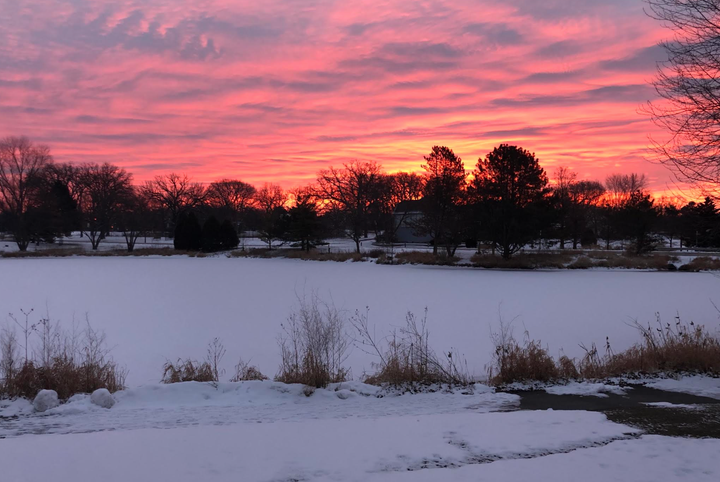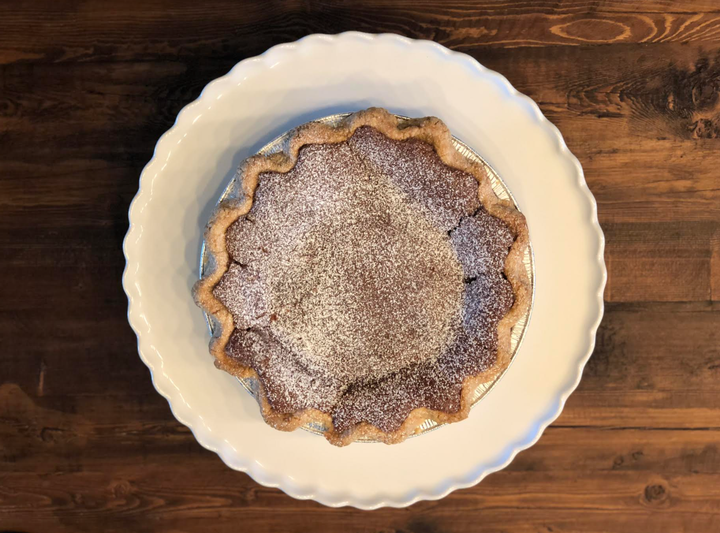
My ice-numb hands shook as I fumbled for my phone in the pocket of my parka. I stared, open-mouthed, at the giant image in the snow. It was clear how they’d done it. Deep boot tracks were still visible. They had simply walked out onto the center of the frozen pond behind my home and then dragged their feet in long, careful lines, with sharp corners, to form a swastika.
I hastily snapped several photos, changing my angle to get different perspectives on the hateful, sprawling thing. I wanted to record every inch of it for — what? To send to the police? To show my husband? I didn’t know. My phone clicked and clicked.
I could guess who was behind it. A small group of teenage boys had been sliding around on the ice in recent weeks. I sometimes watched them through the window while I sipped coffee at my kitchen sink, worrying that they might break through the surface and wondering how long it would take for someone — me maybe — to rescue them from the glacial waters.
I looked to my right and saw a giant ejaculating penis drawn in the snow. Yes, it must have been the boys.
I began kicking at the swastika. Big fluffy clouds of snow flew into the air with each irate swipe of my boot. The image was huge. Ten feet across, maybe even 15. I coughed small, angry sobs into the frigid air and started shuffling across the ice, using my feet as a stupid sort of broom to erase one arm of the figure, then another, and another, and another.
My ugly work complete, I stumbled back into my house and held my frozen hands under a stream of warm water from the tap. I stared at the wreckage out the window. Now what?
I picked up my phone with a red, still-wet hand and began firing off a rage-filled Facebook post to my small neighborhood mom page. “Parents, maybe it’s time to have a talk with your kids about anti-Semitism,” I seethed. I scrolled through the dozen or so photos I’d taken and chose one that showed the symbol clearly despite the haphazardly pitched horizon. In the lower corner was my own shadow, my arms stretched straight up above my head as I held the phone aloft.
Post.
Ping. Ping. Ping. The neighbors were enraged. Good.
“I picked up my phone with a red, still-wet hand and began firing off a rage-filled Facebook post to my small neighborhood mom page. ‘Parents, maybe it’s time to have a talk with your kids about anti-Semitism,’ I seethed.”
Still unsatisfied, I pulled up a larger community page and began typing a similar message. More people needed to know the dreadful jolt I’d just felt. This group had nearly 30,000 members. I wanted to stand right behind every single one of them and give them a hard poke in the side, to scream into their ears that this problem was homegrown and some of them were to blame. I wanted to grip their chins and yank their faces toward this senseless handiwork.
I stopped typing.
I am a non-Jew, raised among the Christian cornfields of Iowa. Though I’ve married into a family with Jewish lineage and happily chosen to raise my daughters with both Christian and Jewish traditions, my own ancestors were not among the millions murdered under the Nazi flag. Was the outrage I felt at this assault even mine to claim? And if it was, by dint of compassion and empathy for a sea of marginalized people, what did I do with it?
Ever the true millennial, I had immediately turned to social media. It was my soapbox and I wanted to use it to highlight this bigotry. But perhaps I needed to be careful. Sharing images of the now-destroyed swastika behind my home would surely get people’s attention, but the type of attention was something I couldn’t determine ahead of time. What if sharing those horrible photos traumatized my Jewish friends? Or worse, what if it somehow encouraged the perpetrators to do more?
Plus, it was just snow. Snow melts. It wasn’t that big of a deal, right?
Only weeks earlier, when the U.S. Capitol had been overrun by violent domestic terrorists, I’d gaped at the image of a man in a “Camp Auschwitz” sweatshirt. Other insurrectionists were photographed wearing shirts that read “6MWE,” a nod to in-the-know Nazis who believe that “6 Million [murdered Jews] Weren’t Enough.” Anti-Semites were stepping out of the shadows and onto the streets of Washington, D.C. They could also, I supposed, be sliding across my neighborhood pond.
My phone continued to ping. I glanced at the comments. Most were of the outraged variety, but not all. One mother noted that she was just as concerned about the fact that the boys had gone onto the ice at all as she was about the swastika. Someone could have been hurt.
Another cautioned that I couldn’t be sure what I saw was a Nazi swastika, since it might have been a Hindu symbol.
I wanted to claw their eyes out.
“The boys who likely created the swastika probably didn’t know who lives on the pond. I assume their drawing was just a terrible, extremely stupid joke. But I will not brush this incident aside the way I cleared the soiled ice. They might not have known any better, but I do.”
The afternoon wore on and my white-hot anger faded into heavy sadness. A friend dropped a package at my front door. I lifted the lid and beheld the treasure inside: a gorgeous chocolate chess pie with perfectly crimped edges and neatly dusted in powdered sugar. The smell of warm butter drifted up through the icy air. A note taped to the box included a joke about how she was sorry for what I’d seen that day, but that pie could probably make it a little better. I chuckled, glad for the gesture and feeling a little silly at the same time that I needed it at all.
I placed the pie on a pretty white cake stand on my dining room table. I stood back and admired the lovely scene it made. It deserved a picture. I climbed up onto a chair and held my phone out over the confection to get a good angle on the pie, snapping photo after careful photo. From above, the white sugar speckled across its dark surface looked like undisturbed snow on a frozen pond.
That evening, my husband and I served our children heaping plates of spaghetti and then taught them about a man named Adolf Hitler. They asked questions. My heart ached.
The boys who likely created the swastika probably didn’t know who lives on the pond. I assume their drawing was just a terrible, extremely stupid joke. But I will not brush this incident aside the way I cleared the soiled ice. They might not have known any better, but I do. I know that when we see something like this, we must address it. Neglecting to do so implies approval, agreement, encouragement.
If I ignored the swastika, at best I’d be allowing the teens to go on doodling one of the most hateful symbols fathomable. At worst I’d be priming their engines for bigger, more dangerous actions down the line. Even if the teens aren’t some budding gang of suburban Nazis and this stunt wasn’t intended to be a direct threat or statement of anti-Semitism, it is still unacceptable. Stumbling upon that swastika saddled me with the responsibility to loudly and clearly cry out: no matter where this came from or why, I will not abide it.
I called the police and filed a report with the Anti-Defamation League. I texted my neighbors to be on the alert for any further hijinks and told them the police were ready to respond the next time the boys were on the ice. And then I ate a slice of the pie. It was just as delicious as it looked.
In the end, I decided that I would share a single image of what happened that day with this essay. This photo would not show the hateful symbol on the ice but instead the kind gesture of a friend. I would tell my troubling story as a warning and grace the internet with a picture of sweet chocolate pie.

Rebecca Siegel is the author of “To Fly Among the Stars: The Hidden Story of the Fight for Women Astronauts” and “Mayflower: The Ship That Started a Nation.” Her writing can also be found in Ad Astra and Scary Mommy. Visit her website or find her on Twitter at @RebeccaSiegel14.
Do you have a compelling personal story you’d like to see published on HuffPost? Find out what we’re looking for here and send us a pitch!
